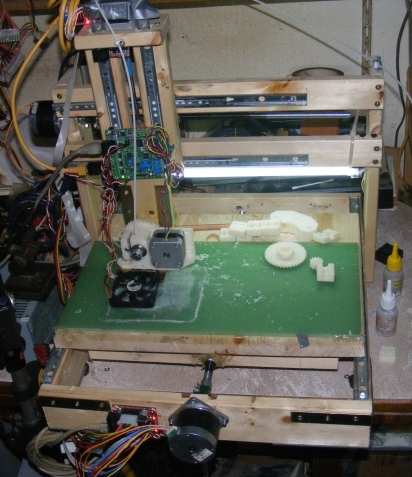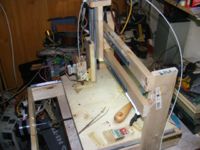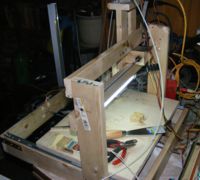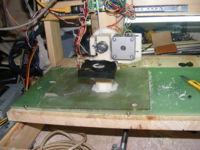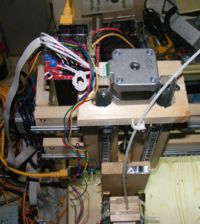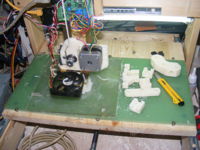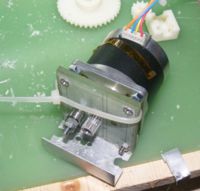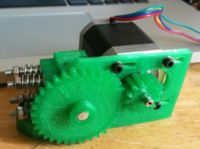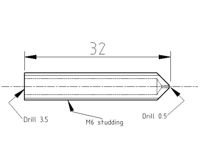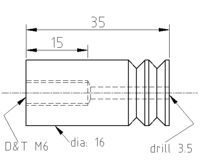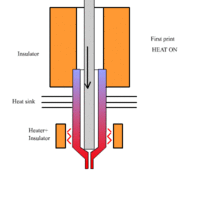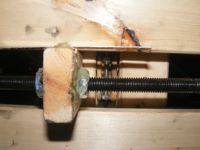WolfStrap
Release status: unknown
| Description | documenting a generic tool/artpiece
|
| License | |
| Author | |
| Contributors | |
| Based-on | |
| Categories | |
| CAD Models | |
| External Link |
These pages should be merged such that both pages do not attempt to cover the duplicate topics.
Contents
Working Notes
Text written in dark magenta has been added by the translator, in order clarify certain aspects of the translation, and is not part of the original German article
Files
Google Sketchup 7 File: File:Reprap.skp
Discussion
http://dev.forums.reprap.org/read.php?1,37355
It is difficult to source parts for the Mendel in Germany, so I was looking for a cheap and easy solution to create the parts for myself.
On top of that it should be mentioned that I am by no means a professional woodworker... the important thing being that it worked.
To me Aesthetics is a foreign word, which I have no knowledge about :)
I didn't plan to publicize this, but I was asked to do so...
Comments and suggestions can be made in the German forums.
The pictures are from different construction and test phases. This is the end result:
Extruder
Intially I created the extruder from a block of wood, but I gave up on that idea.Following that, I build this (image to the left) temporary extruder. The heater has been moved to the new extruder. It was mounted with two small wood screws on the aluminum angle at the base of the motor. The cable tie prevented the filament from sliding out.
I used this to create the Wade's Geared Nema 17 Extruder .Because my construction was so difficult to control, I had to reduce the extruder speed way down in the firmware, unfortunately the stepper driver had problems driving the motor smoothly at that speed.
The Wade-extruder works great.
Even with a 0.28Nm Stepper.Wiki-Geared_Nema17_Extruder
Originally I had planned to make the nozzle in the same manner. I discovered the drawing cannot work this way.
Following a few trials, I performed the following changes:
The drilling in the brass part, specified as 3.5mm, I used a 3mm drill. The drills are rarely very precise, so the hole usually ends up approximately 3.1-3.2mm in diameter. I made the the hole in the teflon part, the isolator, using a 2.8mm drill. On top of that, I shortened the part to only 25mm long, in order to keep the length of the hole shorter. Teflon is very slippery and is relatively soft. Once the fillament is in the hole, it slides quite easily despite the small diameter. The brass part is very hot, so the filament adapts to the shape.What do I achieve by this?
I had the problem that the fillament pushed upwards, out of the nozzle, and as soon as everything was cooled down, the nozzle stopped working. (Animation of a Spoolhead)
This solved that issue.
On top of that, I tighted the end with the brass threading with at hose clamp. This way the part is cooled from the outside and the brass nozzle remains in the teflon part even under pressure. Due to the head, the teflon turns soft, and initially the nozzles were pushed out.
I glued this contraption onto the Wade-extruder using superglue, and it works.
Bill Of Materials
The dimensions given here are for lumber commonly available in Germany. The width and height matches the German building code for laths supporting a roof, the actual dimensions are not terribly important, and can be adopted to dimensions readily available in your area.
Planed roof batten 18x45mm (Dimensions easily available in Germany, just use something of a similar size)
2x 445mm long (drawer slides X-axis)
2x 200mm long (drawer slides Z-axis)
1x ca 300mm long (Attachment for the captive nut, Y-axis)
2x ca 50mm long (Attachment for the captive nut, X-axis and Z-axis)
Planed timber batten 18x70mm (Dimensions easily available in Germany, just use something of a similar size)
2x 415mm long (Base frame)
2x 450mm long (Base frame)
2x 350mm long (Vertical frame, X-axis)
1x 160mm long (Z-axis, extruder mount)
1x 110mm long (Z-axis, motor mount)
A wooden board 30x40x18mm (bed), in order to reduce the mass, a 5 mm plywood will be sufficient, thus the motor will expend less power.
Everything is plain softwood. The cheap kind from the hardware store. (It is not intended to be long lasting)
Be carefull to choose only straight boards and planks. Leave the warped behind. If you intend for the machine to last longer, better quality wood can be used and glued together as well as using screws.
All dimensions are rough measurments, some adaptations will be required, so don't hold me accountable for the exact dimensions :-).
Metal-drawer slides (Do not use plastic slides)
2 pairs 250mm (approximately 10€ a pair)
1 pair 450mm (approximately 12€)
4mmx25mm (a good hand full)
3mmx15mm (a good hand full)
4mmx35mm (a good hand full)
Threaded rod 2x approximately 350mm M10; X-Y-axis (I started out with M5s, which I cannot recommend. The machine will move too slow)
Threaded rod 1x M5 approximately 200mm; Z-axis
And two matching nuts per axis.
Oh yeah, a few pieces of aquarium tubing and 4 hose clamps coupling purposes.
Various metal brackets (for the base frame)]6x 100x100 mm corner braces
4x 120x120 mm flat corner braces
of course hot glue... very important ;-)
Building instructions
Tools required: Try square, measuring tape, dremel, Electric screwdriver, drill bits for wood and a circular saw.
It is best to begin with the body for the bed, all connections should be pre-drilled with the Dremel and a 2.5mm drill bit, so the woold does not crack
Y Axis
For this we need the 4 wood battens 18x70 (415, 450) mm. Right and left the two long parts. Use this make a rectangular frame and if possible try to stay as close to a right angle as possible. The try square be use full for this. Mount the two long drawer slides on on top of this frame. See to it that they are the parallel, otherwise there will be problems later on. Jetzt zieht man die beiden Schienen raus, so das man an die Löcher zum Verschrauben kommt, und legt das ganze umgekehrt auf die Holzplatte , die später die Arbeitsplatte werden soll, und schraubt die fest. Now pull out the two rails, in order to get at the fastening holes on the slides, and turn the frame over and place the slides on the wooden board which will later become the printing bed, fasten the bed tightly. Test whether it slides without resistance back and forth. Great. Great. Now we draw markings for the motor on the front, drill out the holes and mount the motor. This is a bit easier if we remove the board for printing bed again.
Now it is time for the captive nut. We'll need the 300mm piece 18 x 45mm batten. We mount it lengthwise under the bed, and push the bed up against the axle of the motor, just hard enough to make a tiny indentation in the wood (This way you don't have to do any measuring). Drill a 12mm hole where the indentation was made, so the M10 rod can easily fit. Now everything is starting to shape up :-)
Now you can mount the rod to the motor. This requires a piece of aquarium tubing (20-30mm) and push it over the axle of the motor, then tighten the hose to the axle using a hose clamp. Screw a nut on the rod, push the rod through the 12mm hole and add another nut to the other side of the board. Attach the aquarium hose from the motor axle to the rod and tighten the connection using hose clamp. Ensure that it doesn't wobble when the motor is running. The first axis is complete... applause.
X Axis
So now we need the two 18x70x350mm boards and the base frame with the Y-axis. The two boards are positioned in the rear third (approximately 100m from the rear) right and left from the frame. Take great care that the boards are at right angles to the frame and that both the height and distance from the rear is identical, they must be positioned "precisely" opposite each other. You'll need at least 4 screws per board. In order to stabilizing the vertical section we'll attach the crossbeams (18x45x445mm). The first should be flush with the upper edge, ensure that the two vertical boards remain parallel, while attaching the beam. The second should be placed at a distance of about 47-48mm, a 18x45mm board should be able to pass through with comfort, and try to keep the two beams as parallel as possible. It is starting to look quite nicely.
Drill the holse for the motor on the left side. The middle of the motor axle should be 60mm below the top and flush with the board (The motor axls will then be approx 20mm towards the rear). The motor axle should be as far as possible towards the front, otherwise the fastening for the X axis captive nut will have to too long (and unstable).
So until now, everything was quite easy...
Now it is time for the Z axis. For this we need the 18x70x160mm board and the two 18x45x200mm boards. We place the smaller board, which will hold the extruder in front of us and screw the drawer gliders with the small U onto it. As far as possble towards the outer edges, both should be flush with the short side. This is also the side where the detent of the slide drawer is. It is very VERY important to keep the slides parallel, otherwise the Z axis will jam. You must be able to put the motor between the slides, otherwise the motor will not fit later on. Now the two 200mm boards are attached. The outer distance must be 110mm and the edge of the extruder board, where the slides are flush, should also be flush with the two boards. Now everything can be raised up in the vertical, and both drawer slides point upwards (the detent position is downwards). Measure once again if the two boards change their relative distance when the extruder board is moved back and forth, if so, the drawer slides are not parallel. Everything fine? then move on.
The Z axis is standing vertical in front of you, facing the two boards... take a drawer slide, put it sideways in front of you, the detent position towards the right. This is how it is attached, with the small U centered at the lower end of the boards. One small screw per board. Now let it rest on the extruder board, and attach the second drawer slide the same way, parallel, with at distance of approx 80mm above it. I placed a small guide between the two in order to get them parallel. Slide everything back and forth, it must not jam. So far so good.
Now everything has to be mounted on the X axis. The best will be to screw both slides on one side first. Not too tight. Now we have to take care, that everything will be parallel to the bed. I used a small support for this. The left hand side first, placing something/anything as support, since the precise height does not matter. Then I pushed it right, drew markings, and screwed on. Later on you will have to place something on top of the board, since the wood is never totally flat, this way minor mistakes can be corrected. I use the green plate for this.
But... something is still missing... of course, the captive nuts. Now, having mounted the X-axis, it is possible to mark the position for the captive nut on the right board of the Z-axis. I cut a small block of leftover wood 18x45x70mm. The Z axis has to be removed... unfortunately. Only the board with the two drawer slides, the rest should remain attached. When the small block is attached, push it against the motor axle, in order to make a small indentation where the hole (12mm) will need to be drilled. Remove the small block, drill, now glue should be used when it is reattached (this is a weak point). You should be able to push the X-axis back and forth and the block should move between the two crossbeams. Does it? great. Now the threaded rod can be mounted in the same way as with the Y-axis. Don't forget the nuts, one nut on each side of the block.
Now only one board should be leftover. 18x70x110mm where the Z motor will be mounted, in such a way that it is positioned in the middle. As you can see, you need to drill two additional holes besides the motor, otherwise the drawer slides will be om tje way. I use 20mm holes. You will have to measure the exact position. It depends on where you mounted your drawer slides. But you have made it sofar, so you will be able to handle that.
I ran into some issues with the captive nut holder for the Z axis... I tried to do it once more with a small block of wood. Again a piece of the 18x45x25m which I then slotted. I glued two nuts into the slit and screwed the M5 threaded rod onto the nuts. If I had to do it again, I would have used a small angle bracket, the glued nuts in the slit won't hold for long.
My suggestion would be to use a 50x20x15 angle bracket, drill a hole in the short plate for the threaded rod. Then use the same priciple as with the wooden blocks, place a nut on each side of the holes. This is where your ideas will be needed, I cannot chew all you food :-P
If you've come this far: Congratulations, you have held out quite long. Now you are probably asking yourselves, what is the purpose of using two nuts for the blocks... if I tightened both too much, the axle would jam. This way I have neutralized the backlash. First glue one nut with hot glue to the block of wood...now the threaded rod will move the block. If you turn the motor slowly back and forth you'll notice that the movement is delayed, this is the backlash. Because of this tighten the second nut carefully, just so that the rod can still turn and then glue the nut. If I ignored the backlash, it would later be visible in the printed parts, holes will be ovals, corners wouldn't be corners, etc.So, I hope it wasn't too complicated.. if there is anything you haven't understood, feel free to contact me. I'll rewrite the corresponding paragraphs in order to make everything clearer.
The construction time was two days (without building instructions)
- you may keep any typos you find :-)
--Stoffel15 11:35, 3 March 2010 (UTC)
--translated by anton 15:03, 10 March 2010 (UTC)

